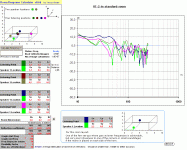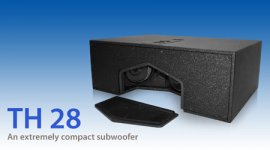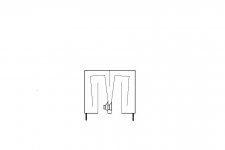Hi,
Have you tried modelling a longer version of the horn? I bet that this will get you closer to your personal experiences than commentaries from us...
With the data I have given you, you should be able to simulate a RT that matches the anecdotal history of bass performance. (dry 30 Hz).
I should build it myself, but have other things to do now.
Have you tried modelling a longer version of the horn? I bet that this will get you closer to your personal experiences than commentaries from us...
With the data I have given you, you should be able to simulate a RT that matches the anecdotal history of bass performance. (dry 30 Hz).
I should build it myself, but have other things to do now.
Hi,
Late, but 2 cent of thoughts about what’s been said about RT-2:
Any speaker can use closeness to sidewalls to furniture’s etcetera, but should be measured in an environment that doesn’t depend on user unique influenced speaker placement where proximity to objects and distances are unknown.
This dependency must be IMO ruled out, i.e. like done for the original FR curve that is correctly showing the horn performance when being measured in Pi environment.
Here my translation of some text taken from the Swedish link I earlier referred to :
///…Schematisk bild av hornet och hur man räknar fram detta ur en befintlig låda. Varje förändring av tvärsnittetets kontinuerliga ökning av arean har mätts. Det framgår av tvärstrecken i schemat. RT-2 slutar med myningen nedtil under lådan. Lådan har ben som gör att utymmet blir ordntligt tilltaget. Det har också placerats en triangelformad låda undertill. Myningen och den triangelformade lådan påstås skapa ett sista hornsegment. Vid simuleringar med detta sista segment stämmer inte frekvenskurvan alls med de mätningar som också gjorts på hornet. Om man inte tar med denna sista bit då stämmer mätningar överens med simuleringar bättre. Därför har den sista biten utelämnats…///
Translated to:
This makes sense since placement of this horn extends the mouth unpredictable as said before.
Post#84
If a RT-2 horn is placed at a third distance of the longest wall of standard room size of 6.5x4.5x2.25 (m) room the FR may extend smoothly but the opposite will probably occur if placed elsewhere but is/was very dependent on room structural design in floor, walls and ceiling.... See picture 1(1).
Have you done measurements or do you have a simulation in Pi space to back up this statement of nominal cut off frequency, back then at late seventies nobody I knew of showed how or had measured such low extension.
I had that wishful thinking thirty years ago too.
Given this statement: This applies to any driver in any enclosure, so what’s the point of mention that at all?
post#102
Of course you can block the sides and rear and maybe at the floor too, this has been tested to extend FR a bit but the WAF disappeared at once.
post#120
Have you done measurements that confirm your statement? Where have you placed the RT-2 horn? Floor plan?
Post#121
IMO, I think extrapolating the RT-2 performance too much without accompanied measurements doesn’t improve this design at all.
If you really want to squeeze out more extension from this design: start to find a driver that uses the enclosure dimensioning optimal (GM posted a good hint) and experiment with different damping of the internal volumes of the closed box compartments.
b
1(1)
Late, but 2 cent of thoughts about what’s been said about RT-2:
Any speaker can use closeness to sidewalls to furniture’s etcetera, but should be measured in an environment that doesn’t depend on user unique influenced speaker placement where proximity to objects and distances are unknown.
This dependency must be IMO ruled out, i.e. like done for the original FR curve that is correctly showing the horn performance when being measured in Pi environment.
Here my translation of some text taken from the Swedish link I earlier referred to :
///…Schematisk bild av hornet och hur man räknar fram detta ur en befintlig låda. Varje förändring av tvärsnittetets kontinuerliga ökning av arean har mätts. Det framgår av tvärstrecken i schemat. RT-2 slutar med myningen nedtil under lådan. Lådan har ben som gör att utymmet blir ordntligt tilltaget. Det har också placerats en triangelformad låda undertill. Myningen och den triangelformade lådan påstås skapa ett sista hornsegment. Vid simuleringar med detta sista segment stämmer inte frekvenskurvan alls med de mätningar som också gjorts på hornet. Om man inte tar med denna sista bit då stämmer mätningar överens med simuleringar bättre. Därför har den sista biten utelämnats…///
Translated to:
A schematic picture of the horn and how to calculate from an existing enclosure:
Each change of the CSA continuous expansion of the area has been measured.
This is shown using cross rules in the schematic. RT-2 throat opening terminates below the enclosure.
The throat and the triangular shaped box are supposed to ensemble an extended horn segment.
When using this segment the FR doesn’t fall together with the measurements done on a real horn.
If this segment is left out when simulating, then the simulation is closer to real measurements.
That’s why this (segment) is left out…
This makes sense since placement of this horn extends the mouth unpredictable as said before.
Post#84
Recommended placement is about 1/3rd down the long wall of your room and then shifting along to find a place that sounds good. Don't place it in a null or node of room resonances.
If a RT-2 horn is placed at a third distance of the longest wall of standard room size of 6.5x4.5x2.25 (m) room the FR may extend smoothly but the opposite will probably occur if placed elsewhere but is/was very dependent on room structural design in floor, walls and ceiling.... See picture 1(1).
…Response down to 40 Hz sounds about right for this horn …
Have you done measurements or do you have a simulation in Pi space to back up this statement of nominal cut off frequency, back then at late seventies nobody I knew of showed how or had measured such low extension.
… maybe with a perfect driver…
I had that wishful thinking thirty years ago too.
…adding damping material here and there and clever filtering/boosting, 30-35 Hz are possible…
Given this statement: This applies to any driver in any enclosure, so what’s the point of mention that at all?
post#102
…Further I am certain that some things could be done to the box on the OUTSIDE, making the outside prolonging more effective and achieve better coupling to outside surroundings…
Of course you can block the sides and rear and maybe at the floor too, this has been tested to extend FR a bit but the WAF disappeared at once.
post#120
…True true, as discussed earlier, these sims don't show the whole trught, and there is certainly more low end response in my livingroom than what the sims indicate…
Have you done measurements that confirm your statement? Where have you placed the RT-2 horn? Floor plan?
Post#121
…Have you tried modelling a longer version of the horn? I bet that this will get you closer to your personal experiences than commentaries from us.With the data I have given you, you should be able to simulate a RT that matches the anecdotal history of bass performance. (dry 30 Hz)…
IMO, I think extrapolating the RT-2 performance too much without accompanied measurements doesn’t improve this design at all.
If you really want to squeeze out more extension from this design: start to find a driver that uses the enclosure dimensioning optimal (GM posted a good hint) and experiment with different damping of the internal volumes of the closed box compartments.
b
1(1)
Attachments
Unfortunately, I don't have any means of making any measurements, so all I can do is to listen and compare with my old sub..
Regarding extending the horn physically..
In the articles published in this sort of horn in 1973 (then with 10" driver), there was an illustration showing the horn flanked by two furniture sections standing on legs at the same height as that of the horn floor.
This was said to extend the low end response noticeably. Would be interesting to try..
Regarding extending the horn physically..
In the articles published in this sort of horn in 1973 (then with 10" driver), there was an illustration showing the horn flanked by two furniture sections standing on legs at the same height as that of the horn floor.
This was said to extend the low end response noticeably. Would be interesting to try..
Well, we did suggest several times to convert it into a "tapped-horn" 
http://www.danleysoundlabs.com/tapped_horn.asp?MODEL=TH 28
http://www.danleysoundlabs.com/tapped_horn.asp?MODEL=TH 28
Attachments
Well, I'm keeping the horn, and since, after reconsidering driver selection philosophy, it turned out to be great sounding. (been listening through some records now..), the next step is to fit the driver properly and give the thing a nice veneered finish.
And since it was eventually sucessfull, I'll post some construction pic's for the benefit of any other that might wish to give it a go!
And since it was eventually sucessfull, I'll post some construction pic's for the benefit of any other that might wish to give it a go!
Originally posted by bjorno Hi,
Late, but 2 cent of thoughts about what’s been said about RT-2:
I reply equally late... Last weeks in one job, first weeks in another, you know how it works.
Any speaker can use closeness to sidewalls to furniture’s etcetera, but should be measured in an environment that doesn’t depend on user unique influenced speaker placement where proximity to objects and distances are unknown.
This dependency must be IMO ruled out, i.e. like done for the original FR curve that is correctly showing the horn performance when being measured in Pi environment.:
Agreed.
This makes sense since placement of this horn extends the mouth unpredictable as said before.
I think that I suggested no more than including the cabinet in simulations. Perhaps this was directed at another poster.
If a RT-2 horn is placed at a third distance of the longest wall of standard room size of 6.5x4.5x2.25 (m) room the FR may extend smoothly but the opposite will probably occur if placed elsewhere but is/was very dependent on room structural design in floor, walls and ceiling.... See picture 1.
Agreed, that´s why I said experiment. One needs a place to start.
Have you done measurements or do you have a simulation in Pi space to back up this statement of nominal cut off frequency, back then at late seventies nobody I knew of showed how or had measured such low extension.
I´ve been emailing and boarding with Swedish and German people `from the seventies`. The Germans were/are building the RT-1 versions, the Swedish are talking about the RT-2 and RT-3. These later models don't seem to have reached the rest of Europe. Anyway, the Germans/RT-1 need some tricks with damping (first segment of horn, apparently damping above 100Hz and virtually extending the horn segment, like stuffing a TL) and careful placement, but they manage 30Hz and even lower. The Swedish don't seem to try as hard and report (memories of) dry 30 Hz with the RT-2.
I have no personal experience other than simulating and reading other people's experience. I base my opinion partly on the original article about the RT-3 and RT-2.
Given this statement: This applies to any driver in any enclosure, so what’s the point of mention that at all? (this was about damping/boosting/driver selection allowing squeezing 30-35 Hz out of it
The efficiency of a horn is generally higher than that of the same driver in a direct radiator enclosure. It might be down by a great number of dB in a certain range, but the actual efficiency in that range may still be higher or equal. Horns reduce cone excursion. They sound more dynamic, certainly in the range where they are most efficient. By choosing a driver that delivers good efficiency and a conveniently boostable response in a horn, you can have that typical horn behaviour in the efficient range and good extension below with roughly equal power use.
It MAY work out very differently. I have had good experience with other horns of my own design and boosting.
- Status
- This old topic is closed. If you want to reopen this topic, contact a moderator using the "Report Post" button.
- Home
- Loudspeakers
- Subwoofers
- RT-2 Horn sub, the result


